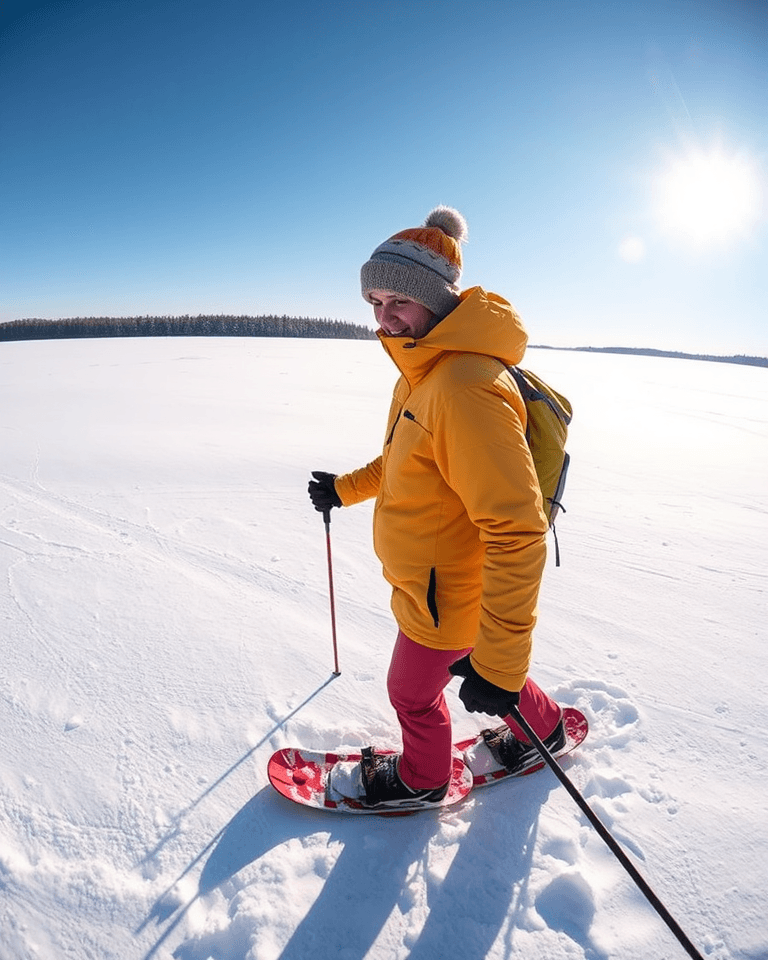As the winter chill sets in, many people retreat indoors, but the colder months offer a unique opportunity to engage in invigorating outdoor activities. Snowshoeing is one such activity, providing an accessible, affordable, and highly beneficial way to stay active and enjoy the beauty of a winter landscape. This low-impact exercise is not only easy to learn, but it also offers a full-body workout, making it an ideal choice for people of all ages and fitness levels.
Getting Started with Snowshoeing
One of the most appealing aspects of snowshoeing is its simplicity. Unlike skiing or snowboarding, which require specialized skills and lessons, snowshoeing is as straightforward as walking. If you can walk, you can snowshoe. The basic technique involves a slightly wider gait to accommodate the snowshoes, and a slow, steady pace is often recommended for beginners.
Essential Gear
The gear required for snowshoeing is minimal and relatively inexpensive compared to other winter sports. The most crucial pieces are:
- Snowshoes: These come in various sizes and designs, with options for flat terrain, rolling hills, and mountainous regions. Beginners can start with flat terrain snowshoes, which offer good value and are designed for easy walking. Renting gear is an excellent way for newcomers to try before buying.
- Waterproof Boots: Warm, waterproof boots are essential for keeping feet dry and comfortable. Hiking boots designed for winter use are suitable.
- Adjustable Poles: While optional, trekking poles with snow baskets can provide extra stability and make ascents easier.
- Appropriate Clothing: Dressing in layers is crucial for staying warm and dry. This includes a moisture-wicking base layer, an insulating mid-layer, and a waterproof outer layer. Don’t forget warm socks, a hat, gloves, and sunglasses.
Health Benefits of Snowshoeing
Beyond being an enjoyable way to explore the outdoors, snowshoeing provides numerous physical and mental health benefits.
Physical Fitness
- Cardiovascular Health: The rhythmic motion of snowshoeing elevates your heart rate, improving circulation and stamina. It’s an effective way to enhance cardiovascular health, engaging both your heart and lungs.
- Calorie Burn: Snowshoeing is a high-calorie-burning activity. Studies suggest that snowshoeing can burn up to 50% more calories than hiking the same distance and elevation. An average person can burn around 600 calories per hour snowshoeing.
- Full-Body Workout: Snowshoeing engages multiple muscle groups, including your legs, core, and arms (if using poles), making it a comprehensive workout. The added weight of snowshoes makes moving more challenging, leading to increased strength and endurance.
- Low-Impact Exercise: Unlike running or other high-impact sports, snowshoeing is gentle on the joints, making it suitable for individuals of all ages and fitness levels, including those with joint issues.
- Improved Balance and Agility: Navigating snowy terrain requires balance and coordination, which can improve overall agility over time.
Mental Well-being
- Mood Booster: Exercise releases endorphins, chemicals in the brain that help improve mood and reduce stress. This is especially beneficial during winter when many people experience seasonal affective disorder (SAD) or feelings of lethargy.
- Stress Reduction: Spending time outdoors in nature has been proven to reduce stress and anxiety. The peace and quiet of a snow-covered landscape can be incredibly calming.
- Mental Resilience: Exercising in the cold requires mental fortitude, helping to build resilience and a “can-do” mindset. Overcoming the challenges of winter workouts can boost your confidence.
- Social Interaction: Snowshoeing can be a fun activity to do with family and friends, providing opportunities for social interaction and shared experiences.
Immune System Boost
- Enhanced Immunity: Exercising in cold weather can help boost the immune system, as your body works harder to defend itself against the elements, potentially reducing the risk of infections. The increased blood flow and circulation from exercise also contributes to a healthier immune system.
- Metabolic Boost: Cold weather exercise can lead to a higher metabolic rate as your body works to maintain its core temperature, leading to burning more energy and fat.
Snowshoeing vs. Hiking
While both snowshoeing and hiking are great ways to enjoy the outdoors, there are key differences between the two.
- Terrain: Hiking is typically done on established trails, while snowshoeing is designed for travel through deep snow, allowing access to areas that might be inaccessible in regular hiking boots.
- Effort: Snowshoeing is generally more challenging than hiking, requiring more effort due to the added weight of snowshoes and the need to lift your feet with each step.
- Impact: While both are low-impact activities, snowshoeing is often softer on the joints, especially when compared to hiking on uneven surfaces. The snow can also level out jagged trails, making them easier to navigate.
- Calorie Burn: Snowshoeing typically burns more calories than hiking. Studies indicate that snowshoeing can burn up to 50% more energy than hiking for the same distance and elevation.
Where to Snowshoe
Many locations offer excellent snowshoeing opportunities, ranging from groomed trails to backcountry adventures. Here are some ideas:
- National and State Parks: Many parks offer designated snowshoe trails and stunning winter scenery. Popular options include Acadia National Park in Maine, Yosemite National Park in California, and Rocky Mountain National Park in Colorado.
- Local Trails and Nature Preserves: Check out local parks and preserves, as these often have trails suitable for snowshoeing. For instance, Codorus State Park in Pennsylvania offers miles of trails perfect for beginners.
- Ski Resorts: Some ski resorts have designated snowshoe trails, often providing access to scenic areas and offering rentals and tours. Sugarloaf Outdoor Center in Maine and Mt. Seymour in British Columbia are a few examples.
- Guided Tours: For those new to snowshoeing or looking to explore unfamiliar areas, guided snowshoe tours are a great option. Many outfitters offer tours that include gear rental and instruction.
Tips for Beginners
- Start Slow: Begin with short, easy trails to get used to snowshoeing before attempting more challenging routes.
- Stay Hydrated: Even in cold weather, it’s important to stay hydrated. Bring a water bottle or hydration pack.
- Bring Snacks: Pack energy bars, trail mix, or other snacks to keep your energy levels up.
- Check the Weather: Always check the weather forecast before heading out and dress accordingly.
- Be Aware of Your Surroundings: Pay attention to the trail and be mindful of potential hazards like ice or uneven terrain.
- Go With a Friend: It’s always safer to snowshoe with a partner, especially in remote areas.
- Let Someone Know Your Plans: Tell someone where you’re going and when you expect to return.
Conclusion
Snowshoeing is a fantastic way to embrace winter, offering a combination of physical fitness, mental well-being, and outdoor adventure. Its accessibility and affordability make it a great choice for people of all ages and fitness levels. Whether you’re looking for a gentle stroll through a snowy landscape or a more challenging workout, snowshoeing has something to offer. So, gear up, get outside, and discover the joys of winter on snowshoes.







